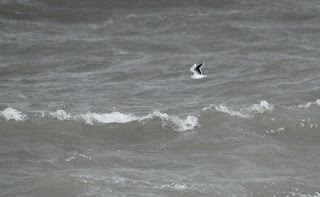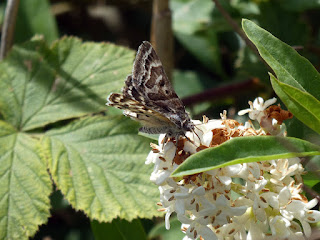Norfolk and the Wash
I genuinely think I nailed it this year with uni birding and the carbon footprint side of things, finding a necessary balance between the two. I'm a firm believer in staying green as much as possible, but don't think that travelling a bit is unreasonable or wrong. It would be pretty unfair to suggest, as some often do, that climate change means travelling by car is now always unacceptable. So many of us haven't had the opportunity to travel as much before, and with a decent amount of climate conscience, which most nature geeks both young and older have, driving to places is obviously not exclusively wrong or bad (to me at least.) Essentially, if the opportunity arose, I was always going to go birding a bit further afield if possible!
 |
| Glossy Ibis spam - sorry... |
Unsurprisingly as I don't drive yet, I owe a lot of thanks to those able to tolerate me for a few hours. By the end of my first month, Alex Berryman was kind enough to pick me up fairly early one morning as we went in search of a Ferruginous Duck (and/or American Wigeon,) failing with both. Between the sites visited, we did however manage impressive views of Glossy Ibis (same place I sound recorded them with Luke 3 months on) as well as Whooper Swan, Crane and Cattle Egret amongst thousands of waders and ducks on the wash. A visit 2 weeks later to the wash this time with Ollie and Alex saw similar species noted. The wash, being about 45 minutes away, is perfect to visit for a morning or half a day - me and Ollie did another outing there in February, visiting Welney for the first time, where 2 Bewick's Swans (poor effort,) Short-eared Owls, Tree Sparrows and Cattle Egrets were among the highlights.
 |
| Cranes on the Wash |
 |
| Whooper Swans |
 |
| Tree Sparrow - Welney |
 |
| Reed Bunting - Welney |
It'll be no shock to anyone that the moment I realised I was going to Cambridge, my eyes were immediately drawn to the Norfolk coast. After a trip in December 2019 where I first experienced the magic of winter in Norfolk, the thought of visiting in autumn was enough to stop me sleeping much the night before the first planned trip, in mid November. As I may have said, last autumn was so dreadful that unlike most years, October didn't bring much by way of easterly winds or worthwhile opportunities to head to the coast. In hindsight, I was a bit too optimistic when we finally got NE winds in November, where we failed miserably to find or really see anything of special note. Myself, Isaac, Alex and Ben Jobson did manage to see species such as Hen Harrier, Shorelark, Eiders, Glossy Ibis, Manx Shearwater in addition to thousands of geese, ducks and waders. Bit of birding snobbery from us there - technically we had no right to be disappointed with what was still a decent day...
 |
| Grey Plovers and Dunlin |
 |
| Brent Geese |
 |
| Grey Partridge |
 |
| Grey Partridge |
 |
| Shorelark |
 |
|
All the trips I've done have been car shares of 3 or 4 of us. The second trip to Norfolk was, in terms of quality over quantity, far better. Keir was up for the first time and in the middle of the late November cold spell. Thanks to Dan Field who gave myself, Keir and Ollie a lift, we decided it would be smart to fight strong, freezing northerlies on the beach of Cley (after stopping briefly at Lynford Arboretum, where Marsh Tit and Woodcock were best.) We did, of course, miss two interesting scoters which went through when we went looking for Snow Bunting, some suggesting one may have been White-winged. The highlights of the day were, not to forget the Little Gulls, Shorelarks and Snow Buntings, seabirds, the pick of which was an unfortunately probably doomed Little Auk, my first ever. I've got huge admiration for hardy birds like Little Auks - the Goldcrest of seabirds almost. Something so tiny and fragile, yet capable of fighting waves and storms that many humans couldn't. Respect.
 |
| Little Gull, Cley |
 |
| 1st winter 'argentatus' Herring Gull - the strong, cold northerlies brought many of these brutes down |
South  |
| Snow Bunting |
 |
| A doomed Cley seal - I horrified the guys when we saw it, 'give it a week and that's Arctic gull food'. Tbc... |
 |
| Little Auk |
The only other trip to Norfolk I've been on was in February this year, mostly to twitch a long-staying Red-breasted Goose at Blakeney/Cley with Ben and Alex. It was seen but ridiculously far away, a common theme for the day. We also saw Short-toed Lark, my second in the UK, even if views were even worse than those of the Goose. In addition to these, I heard my first Lesser-spotted Woodpecker in the Thetford Forest - Black Redstart, singing Woodlark, juvenile Iceland Gull, waders like Grey Plover and more were all also noted. Even if the rarities showed poorly, it was a much needed away day, and one I thoroughly enjoyed. The coast never fails to lift me!
 |
| Red-breasted Goose - this is 100% the wild one |
 |
| Black Redstart |
 |
| Grey Plovers |
 |
| juvenile Iceland Gull - a bird that spent most of the winter enjoying the very seal I suggested to be white winger food in November |
Socials and Things to take away
Besides the Norfolk coast and the wash, most away days/half-days were spent with Ollie, who I'm lucky enough to have become pretty good mates with since coming (even if he selfishly abandoned me in March to be assistant warden at Bardsey for the season.) Before he left, we spent much of our time out dipping various things. Some examples of dips include Great Grey Shrike, Tundra Bean Goose and a local overwintering Hoopoe at Duxford (twice.) Essentially, me and Ollie currently have a poor record when out - one to correct when he returns hopefully!
The only other place I visited, in mid May, was the Thetford Forest for a Geography Fieldtrip, where Woodlark, Tree Pipit, Hawfinch and Cuckoo were all observed while doing research. Just another reason Geography is such an elite subject.
 |
| Thetford Forest |
Especially given I was without a car or bike, I'm really pleased with how the first year has gone for birding and wildlife watching. Cambridge has provided a lot of opportunity to stay local, with plenty of sites worth visiting, many of which are fairly underwatched. What's possibly just as good here is the farmland and ecosystems in general. Unlike most places near me where there are similar habitats, most fields hold Skylark and Lapwing, whilst being bordered by hedgerows and shrubs rather than just fences. It's no surprise that the county is still a stronghold for species like Turtle Dove, a species I've often spent mornings specifically out for. It's noticeable how many more sylvia warblers especially, such as Garden Warblers, there are in Cambridgeshire compared to elsewhere. The same goes for Cuckoos, Corn Buntings, Yellowhammers, Cattle Egrets and Partridges just to name a few others. When friends have come, I think these are the things we've all enjoyed seeing as much as many other species, and is why the fens, though sometimes a bit bleak and flat, is so rewarding for long walks.
 |
| Southern Marsh Orchid apparently |
 |
| Fulbourn Fen |
One of the main things I've learnt is that although I love London and city life - I'd definitely struggle away from urban areas - a place like Cambridge has served me well. On the whole, having more control over how I spend my time has helped better deal with mental health, which has continued to be a problem, especially in the winter. Like many birders seem to, things to do with the environment can be so grim that it sometimes can just add to problems as much as solve them - lots of what Steve wrote in his blog here I could strongly relate to.
I've had some major highs and lows with birding recently - my inability to find birds, though something my mates and I laugh about and something which should realistically mean absolutely nothing, has dragged me down a lot at times. Being so reliant on the hobby, times when I feel like I'm 'not good at it' just add to any other frustrations there are. That said, birding has easily been my main coping mechanism from work stress and mental health. Separating birding from going walking (even if I'm never not looking for things) has definitely helped.
 |
| Wilbraham Patch photos |
And the final, other thing that's helped has been the social side of things birding has brought out. Being a representative of the BTO has become more enjoyable given the office is about 400 metres from my front door, allowing me to benefit from the people side of things again, as hoped for before lockdown - mostly thanking Faye and Chris from the BTO team for seeing me way too often I suspect! I'm feeling quite motivated to return to my environmental/campaign ways next year now I've settled in, with an undergrad environment/nature society possibly in the making,,,
One of the only things as good as birding and cricket is a pub social for me, so having a new group of people to occasionally catch up with over a beer and chips has done as much good as birding itself - more thanks to Ollie, Ben, Alex, Isaac and Dan for the occasional company there. Also adding thanks to mates who've come to visit and local birders who I've bumped into on a number of occasions, many of which who've given me information or lifts (massive shout out to Jon Heath and Andrew Dobson particularly.) And last but not least, some of the guys at uni who have joined me on walks, taking some interest in my strange hobby (mostly Kiran who I've dragged birding with me - to be fair, he wasn't that unwilling, and has taken some photos I wouldn't have managed!) Fingers crossed that when I return in October more pub evenings and birding socials await :)
 |
| Paradise LNR |
 |
| Grantchester Meadows |
 |
| River Cam |
Some of Kiran's photos from a morning spent birding Wilbraham in June are here.
 |
| Common Blue damsel |
 |
| Wilbrahams |
 |
| Common Lizard, Wilbraham Common |
 |
| Mother Shipton moth |
































































No comments:
Post a Comment